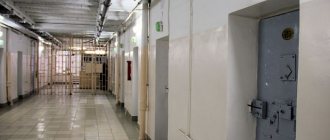New edition of Art. 181 Code of Criminal Procedure of the Russian Federation
In order to verify and clarify data relevant to a criminal case, the investigator has the right to conduct an investigative experiment by reproducing actions, as well as the situation or other circumstances of a certain event. At the same time, the possibility of perceiving any facts, performing certain actions, the occurrence of any event is checked, and the sequence of the event and the mechanism for the formation of traces are identified. An investigative experiment is permitted if there is no danger to the health of the persons participating in it.
What is an investigative experiment and what are its goals?
During the investigation, there is often a need to check certain circumstances or phenomena in the case under conditions close to reality.
Here are some examples of investigative experiments:
- could the citizen hear or see something about the offense from the place where he was at that time;
- is it possible to enter the scene of the theft;
- is it possible to transport goods by the method specified by the person in a car of a certain brand, etc.
This procedure is regulated by Art. 181 of the Code of Criminal Procedure of the Russian Federation, and its goals are as follows:
- establishing the truth of what happened;
- comparison of facial testimony with what took place in reality;
- study of a citizen's actions during a crime.
Commentary on Article 13 of the Code of Criminal Procedure of the Russian Federation
1. Secrecy of correspondence, telephone and other conversations, postal, telegraph and other messages, i.e. The secret of communication lies in the fact that information about postal items, telephone conversations, telegraph and other messages, as well as these items (messages) themselves, can only be given to senders and addressees or their legal representatives. Delay, inspection and seizure of mail and documentary correspondence, wiretapping of telephone conversations and familiarization with telecommunication messages, as well as other restrictions on the secrecy of communications are allowed only on the basis of a court decision (Articles 63 - 64 of the Federal Law of June 7, 2003 N 126-FZ " On Communications"; Article 15 of the Federal Law dated July 17, 1999 N 176-FZ "On Postal Communications").
2. As the Constitutional Court of the Russian Federation established, information constituting the secrecy of telephone conversations protected by the Constitution of the Russian Federation and the laws in force on the territory of the Russian Federation is considered to be any information transmitted, stored and installed using telephone equipment, including data on incoming and outgoing connection signals of specific telephone sets communication users. To access this information, authorities carrying out operational investigative activities must obtain a court decision. Otherwise, it would mean non-compliance with the requirement of Article 23 (Part 2) of the Constitution of the Russian Federation on the possibility of limiting the right to privacy of telephone conversations only on the basis of a court decision <1>.
——————————— <1> See: Ruling of the Constitutional Court of the Russian Federation dated October 2, 2003 N 345-O on the refusal to accept for consideration the request of the Sovetsky District Court of the city of Lipetsk to verify the constitutionality of Part 4 of Art. 32 Federal Law of February 16, 1995 “On Communications” // Russian newspaper. 12/10/2003. N 250.
3. In judicial and investigative practice, the question arises <1>: does the right to privacy of correspondence, telephone conversations, postal, telegraph and other messages limit the inspection of a mobile phone seized from a person, aimed at obtaining information contained in his electronic memory (“address book”) ")? It should be borne in mind that the principle of maintaining the secrecy of telephone conversations, which requires a special guarantee in the form of judicial permission for third parties (inquiry, preliminary investigation and court) access to transmitted information, protects only that information that is covered by a tri- or bilateral legal relationship involving telecom operator (subscribers - telecom operator). This is explained, firstly, by the fact that it is the telecom operator that clients, conducting telephone and other conversations over telecommunication networks (similar to how they do this over postal networks), entrust confidential information, and such trust must be especially protected by law against possible betrayal. Secondly, the telecom operator is technically most ready to quickly and completely transfer information about the subscriber to third parties, which poses an increased danger for subscribers in the event of its dishonesty. Consequently, information about connections that has left the sphere of responsibility of the telecom operator (legal relations with his participation) by fixing it in the phone’s memory, as such, is no longer subject to protection through judicial control, unless, of course, there are other legal grounds for this (search in home, personal search not related to the detention of a suspect, etc.).
——————————— <1> See: clause 1 of the Constitutional Court of the Russian Federation of 04/08/2010 N 433-О-О.
Types of investigative experiments
Two main groups:
- Reproduction of facial actions.
- Reconstruction of events that do not depend on the citizen.
The first group includes the following investigative experiments:
- the perception of a fact in the conditions that the person himself spoke about (for example, whether he could hear something from a certain place);
- commission of an action (whether it was possible to enter the premises the way the alleged thief did);
- reproduction of actions that require certain skills (would it be possible to tie a knot in the same way, etc.).
The second group consists of the following:
- the possibility of the occurrence of any phenomenon or incident (can sediment form in the drink over a certain period of time, etc.);
- the mechanism of the entire event or its individual stages (could the engine in the car stop working for one reason or another);
- the process of creating traces (for example, whether the seized objects could be used to commit an offense).
Article 181 of the Code of Criminal Procedure of the Russian Federation. Investigative experiment (current edition)
1. An investigative experiment as a special testing investigative action is not considered urgent. The content of this investigative action consists of experimental, research actions, but not related to the use of special knowledge. This is the difference between an experiment and an examination, and this is its special condition.
2. During the experiment, experimental actions can be repeated several times with changes in any parameters.
3. An investigative experiment as a simulation must be subject to a general rule - the accuracy of recreating the conditions under which the actions or events being tested occurred. The model objectively reflects only some of the characteristics of the object—the original. Depending on these verified features, the degree of accuracy of the reconstruction of conditions (subject of the action, time, place, lighting, etc.) is determined. The degree of accuracy of the model reconstruction is the most important criterion for assessing the reliability of the experimental results.
4. There are several types of investigative experiments, which in terms of content can be conditionally divided into two groups: 1) consisting in the reproduction of actions (acts of will); 2) consisting in the reconstruction of events (circumstances that do not depend on the will of a person). According to the goals, the first group is divided into experiments to establish the possibility of: a) the perception of any fact under certain conditions (whether the witness could see or hear from such a distance); b) committing a certain action (could the accused enter the premises through a window, take out such a volume of things within a specified time); c) committing actions requiring special skills (could the accused produce drugs using this equipment, could the victim tie a sea knot). The second group of experiments, consisting in the reconstruction of an event, is carried out to establish: a) the possibility of the occurrence of any phenomenon or fact (can a web form on a given break in 15 hours); b) the mechanism of the event as a whole or its individual parts (whether certain actions entail disengagement of the mounting belt); c) the mechanism for the formation of traces (which tools seized from the accused leave similar traces of burglary).
5. Obligatory participants in this investigative action are attesting witnesses (Article 170). For other mandatory and optional participants, see the commentary. to Art. 164.
Comment source:
Ed. A.V. Smirnova “COMMENTARY ON THE CRIMINAL PROCEDURE CODE OF THE RUSSIAN FEDERATION” (ARTICLE BY ARTICLE), 5th edition
SMIRNOV A.V., KALINOVSKY K.B., 2009
Brief content of the article. 181 Code of Criminal Procedure of the Russian Federation with comments
It contains the definition of the term, which we have already discussed above, as well as its types (we also talked about them in the previous section). The investigator is responsible for carrying out the investigative experiment, and he is obliged to maintain safety for all participants in the process.
Throughout the entire procedure, it is allowed to use the same actions, but with some changes in the parameters. The main goal is to recreate the necessary conditions for the entire process to take place.
Mandatory participants in the experiment are witnesses, the investigator, the citizen himself and technical specialists, but it is carried out precisely on the initiative of an employee of the investigative agency. This is the main difference between checking testimony on the spot and an investigative experiment.
Commentary on Article 181 of the Code of Criminal Procedure of the Russian Federation
1. An investigative experiment as a special testing investigative action is not considered urgent. The content of this investigative action consists of experimental, research actions, but not related to the use of special knowledge. This is the difference between an experiment and an examination, and this is its special condition.
2. During the experiment, experimental actions can be repeated several times with changes in any parameters.
3. An investigative experiment as a simulation must be subject to a general rule - the accuracy of recreating the conditions under which the actions or events being tested occurred. The model objectively reflects only some of the characteristics of the object—the original. Depending on these verified features, the degree of accuracy of the reconstruction of conditions (subject of the action, time, place, lighting, etc.) is determined. The degree of accuracy of the model reconstruction is the most important criterion for assessing the reliability of the experimental results.
4. There are several types of investigative experiments, which in terms of content can be conditionally divided into two groups: 1) consisting in the reproduction of actions (acts of will); 2) consisting in the reconstruction of events (circumstances that do not depend on the will of a person). According to the goals, the first group is divided into experiments to establish the possibility of: a) the perception of any fact under certain conditions (whether the witness could see or hear from such a distance); b) committing a certain action (could the accused enter the premises through a window, take out such a volume of things within a specified time); c) committing actions requiring special skills (could the accused produce drugs using this equipment, could the victim tie a sea knot). The second group of experiments, consisting in the reconstruction of an event, is carried out to establish: a) the possibility of the occurrence of any phenomenon or fact (can a web form on a given break in 15 hours); b) the mechanism of the event as a whole or its individual parts (whether certain actions entail disengagement of the mounting belt); c) the mechanism for the formation of traces (which tools seized from the accused leave similar traces of burglary).
5. Obligatory participants in this investigative action are attesting witnesses (Article 170). For other mandatory and optional participants, see com. to Art. 164.
Who conducts
Potential offenders, victims of crimes or other participants in the proceedings can apply for this procedure, but only the investigator has the right to conduct the experiment itself.
Only an employee of the investigative agency is able to assess whether the entire procedure is being carried out objectively and correctly. Specialists and witnesses can also participate in it. Inviting the latter is a must. If the process proceeds without them, it will not be considered legal.
Commentary on Article 189 of the Code of Criminal Procedure of the Russian Federation
1. To the general rules of interrogation (procedural rules relating to all its types) in addition to those contained in the com. article taking into account Art. 164 of the Code of Criminal Procedure includes: a) grounds, conditions and purposes of interrogation; b) place, time and duration of interrogation; c) the general rights of the interrogated person, the procedure for calling him; d) subject of interrogation; e) procedure and techniques of interrogation; f) the circle of optional interrogation participants; g) recording the progress and results of the interrogation.
2. The general rights of the interrogated person include: a) the right to respectful treatment (Article 21 of the Constitution of the Russian Federation; Article 9, Part 4 of Article 164 of the Code of Criminal Procedure); b) the right not to testify against oneself and one’s loved ones (Article 51 of the Constitution of the Russian Federation). If he agrees to testify, the interrogated person is warned that his testimony will be used as evidence even if he subsequently refuses it (part 2 of article 11, part 4 of article 56 of the Code of Criminal Procedure); c) the right to testify in one’s native language or in a language one is fluent in, as well as the right to use the services of an interpreter free of charge (part 2 of article 18, part 1 of article 189 of the Code of Criminal Procedure); d) the right to use documents and records when giving testimony (Part 3 of Article 189 of the Code of Criminal Procedure); e) the right to legal assistance (Article 48 of the Constitution of the Russian Federation). The suspect and accused have the right to use the services of a defense lawyer, and the witness has the right to testify in the presence of his lawyer (Part 5 of Article 189 of the Code of Criminal Procedure); f) the right to familiarize yourself with the interrogation protocol, to make comments, additions and clarifications (Part 6 of Article 190 of the Code of Criminal Procedure); g) the right to produce diagrams, drawings, drawings during interrogation (Part 5 of Article 190 of the Code of Criminal Procedure).
3. A question that contains an answer is considered leading. (“Didn’t the accused have a blue suit?”) Judicial practice equates questions with elements of suggestion, as well as the disclosure of testimony of other persons in cases not provided for by law, to leading questions.
4. The commented article is silent about the fact that witnesses summoned in the same case are interrogated separately and in the absence of other witnesses. The investigator’s obligation to take measures to ensure that interrogated witnesses in the same criminal case cannot communicate with each other was not reinforced in the preliminary investigation. However, it would be erroneous to conclude that it is tactically possible for an unexamined witness to be present while another person is testifying. Firstly, the rule of separate questioning of witnesses is clearly established for judicial investigations (Part 2 of Article 264, Article 278). Secondly, joint questioning of witnesses is fraught with the possibility of asking leading questions, which is also prohibited in a preliminary investigation (Part 2 of Article 189). Joint questioning of witnesses gives rise to difficult to eliminate doubts about the reliability of their testimony. Therefore, in investigative practice one should apply an analogy to the norms of judicial investigation (Part 2 of Article 264, Article 278).
The situation is different with the presence of a suspect, accused, or victim during interrogation. They are parties to the process and as parties should be able to know the primary sources of evidence. The accused has the right to interrogate witnesses against him (subsection “e”, paragraph 3, article 14 of the International Covenant on Civil and Political Rights; subsection “d”, paragraph 3, article 6 of the Convention for the Protection of Human Rights and Fundamental Freedoms). Therefore, the parties have the right to be present at the interrogation (as well as to participate in procedural actions). For the difference between an interrogation with the participation of the parties and a confrontation, see com. to Art. 192. The current law directly provides for the participation of the victim, suspect and accused only in those investigative actions that are carried out at their request (clause 9, part 1, article 42, clause 9, part 4, article 46, clause 10, part 4 Article 47 of the Code of Criminal Procedure). Taking into account the above-mentioned international legal norm on the right of the accused to interrogate witnesses testifying against him, ensuring such participation, in our opinion, is mandatory for the investigator. Moreover, it is sometimes even beneficial for the investigator as a prosecutor to ensure the presence of the defense during interrogation. The participation of the defense attorney in the interrogation of the prosecution witness will strengthen the evidentiary value of the interrogation protocol. In a judicial investigation, as a general rule, the interrogation protocol is read out with the consent of the parties (Article 281 of the Code of Criminal Procedure). If the defense attorney was present during the interrogation of the witness, then he will have less reason to object to the readout of the protocol. And vice versa, if the rights of the defense are limited, then the interrogation record will not be able to become evidence in court.
5. The procedural law does not require starting the interrogation on the merits of the case with a free story from the interrogated person, as was the case according to Part 5 of Art. 150 and part 5 of Art. 158 Code of Criminal Procedure of the RSFSR. The current Code provides for a free story only for checking testimony on the spot (Part 4 of Article 194). Is it possible based on this to come to the conclusion that a free story at the beginning of the interrogation has become just one of the tactical techniques that can be used or not used solely at the discretion of the investigator? When answering this question, it should be borne in mind that in accordance with Art. 10 of the European Convention for the Protection of Human Rights and Fundamental Freedoms of November 4, 1950, everyone has the right to freedom of expression. This right includes, in particular, the freedom of any person (including, obviously, a witness, an accused, a suspect) to hold his own opinion, to receive and disseminate information without interference from government authorities. The exercise of these freedoms may be subject to such restrictions as are necessary in a democratic society only in the interests of national security, territorial integrity or public safety, to prevent disorder or crime, to protect health or morals, to protect the reputation or rights of others, or to prevent the disclosure of information received in confidence , or ensuring the authority and impartiality of justice. The mentioned conditions for limiting the expression of opinion can hardly be extended to the right of the interrogated person to freely tell during the interrogation everything that he considers necessary. The only exception, apparently, is information that is clearly not related to the criminal case, since cluttering the investigation materials with unnecessary information does not contribute to the authority of justice. Thus, on the basis of this generally recognized norm of international law, it should be concluded that free speech is still the right of interrogated persons. The Code of Criminal Procedure of the Russian Federation does not provide for the possibility of hand-written recording of testimony. At the same time, handwritten recording of testimony, for the same reasons as a free story, seems possible, and when interrogating an expert or specialist, advisable.
6. According to Part 5 of Com. Article a witness has the right to appear for questioning with a lawyer. This means that the interrogation should not be delayed for the appearance of a lawyer.
Tactics
The tactics of an investigative experiment are understood as those actions taken by the investigator to conduct the process. This ensures its legality and validity.
Principles of the procedure:
- the experiment is carried out in conditions that are as similar as possible to those that existed during the incident itself (this may be the scene of a crime or a reconstructed situation);
- To do this, several actions take place in a logical sequence;
- repeating them is not prohibited; on the contrary, it helps to establish real events.
The whole process is divided into three stages:
- preparatory;
- worker;
- final.
Preparation
Conducting an investigative experiment is permitted only after all preparatory processes have been followed.
Preparation takes place before the entire group leaves for the experiment site. The investigator determines who will participate in the procedure, what technical means will be used, and what his goals and objectives are. He draws up a plan for the event, ensures the arrival of all participants and orders transport.
After the participants arrive at the scene of the incident, the situation itself is prepared and a check is made to see whether everything has been taken into account and to what extent all participants are aware of their rights. They are also warned about the liability arising under Art. 307 and 308 of the Criminal Code of the Russian Federation.
Production
It begins after the citizen, in respect of whom the experiment is being conducted, testifies about the situation and actions he performed at the scene of the incident. The investigator then asks him to show what he was doing at each specific time period.
At the same time, he should not forget about the psychology of the investigative experiment, since it can be difficult for victims to remember traumatic events.
The investigator has the right to ask to repeat the sequence of events and make any changes during their implementation. If the need arises, he consults with specialists.
If actions are performed by different people, each of them takes turns showing what they did. If one of them is missing, actions are performed by those who are most similar to these citizens.
Final stage and evaluation
During the last stage, the investigative experiment protocol form is filled out. It is accompanied by recordings of cameras installed during the experiment.
After the end of the process, the investigative experiment is carefully checked and evaluated.
Evaluation of the experiment includes the following steps:
- checking its goals, objectives, content and sequence of actions;
- comparison of the conditions under which the experiment was carried out with those that took place in reality;
- evaluation of tactical methods;
- comparison of the results obtained with other evidence in the case.
Article 189 of the Code of Criminal Procedure of the Russian Federation. General rules for interrogation (current version)
1. To the general rules for interrogation (procedural rules relating to all its types), in addition to those contained in the commented article, taking into account Art. 164 of the Code of Criminal Procedure includes: a) grounds, conditions and purposes of interrogation; b) place, time and duration of interrogation; c) the general rights of the interrogated person, the procedure for calling him; d) subject of interrogation; e) procedure and techniques of interrogation; f) the circle of optional interrogation participants; g) recording the progress and results of the interrogation.
2. The general rights of the interrogated person include: a) the right to respectful treatment (Article 21 of the Constitution of the Russian Federation, Article 9, Part 4 of Article 164 of the Code of Criminal Procedure); b) the right not to testify against oneself and one’s loved ones (Article 51 of the Constitution of the Russian Federation). If he agrees to testify, the interrogated person is warned that his testimony will be used as evidence even if he subsequently refuses it (Part 2 of Article 11; Part 4 of Article 56 of the Code of Criminal Procedure); c) the right to testify in one’s native language or in a language one is fluent in, as well as the right to use the services of an interpreter free of charge (Part 2 of Article 18; Part 1 of Article 189 of the Code of Criminal Procedure); d) the right to use documents and records when giving testimony (Part 3 of Article 189 of the Code of Criminal Procedure); e) the right to legal assistance (Article 48 of the Constitution of the Russian Federation). The suspect and accused have the right to use the services of a defense lawyer, and the witness has the right to testify in the presence of his lawyer (Part 5 of Article 189 of the Code of Criminal Procedure); f) the right to familiarize yourself with the interrogation protocol, to make comments, additions and clarifications (Part 6 of Article 190 of the Code of Criminal Procedure); g) the right to produce diagrams, drawings, drawings during interrogation (Part 5 of Article 190 of the Code of Criminal Procedure).
3. A question that contains an answer is considered leading. (Wasn’t the accused wearing a blue suit?) Judicial practice equates questions with elements of suggestion, as well as the disclosure of testimony of other persons in cases not provided for by law, to leading questions.
4. The commented article is silent about the fact that witnesses summoned in the same case are interrogated separately and in the absence of other witnesses. The investigator’s obligation to take measures to ensure that interrogated witnesses in the same criminal case cannot communicate with each other was not reinforced in the preliminary investigation. However, it would be erroneous to conclude that it is tactically possible for an unexamined witness to be present while another person is testifying. Firstly, the rule of separate questioning of witnesses is clearly established for judicial investigations (Part 2 of Article 264, Article 278). Secondly, joint questioning of witnesses is fraught with the possibility of asking leading questions, which is also prohibited in a preliminary investigation (Part 2 of Article 189). Joint questioning of witnesses gives rise to intractable doubts about the reliability of their testimony. Therefore, in investigative practice one should apply an analogy to the norms of judicial investigation (Part 2 of Article 264, Article 278).
The situation is different with the presence of a suspect, accused, or victim during interrogation. They are parties to the process and as parties should be able to know the primary sources of evidence. The accused has the right to interrogate witnesses against him (Article 14, paragraph 3e, of the International Covenant on Civil and Political Rights; Article 6, paragraph 3d, of the Convention for the Protection of Human Rights and Fundamental Freedoms). Therefore, the parties have the right to be present at the interrogation (as well as to participate in procedural actions). For the difference between an interrogation with the participation of the parties and a confrontation, see the commentary. to Art. 192. The current law directly provides for the participation of the victim, suspect and accused only in those investigative actions that are carried out at their request (clause 9, part 1, article 42, clause 9, part 4, article 46, clause 10, part 4 Article 47 of the Code of Criminal Procedure). Taking into account the above-mentioned international legal norm on the right of the accused to interrogate witnesses testifying against him, ensuring such participation, in our opinion, is mandatory for the investigator. Moreover, it is sometimes even “beneficial” for the investigator as a prosecutor to ensure the presence of the defense during interrogation. The participation of the defense attorney in the interrogation of the prosecution witness will strengthen the evidentiary value of the interrogation protocol. In a judicial investigation, as a general rule, the interrogation protocol is read out with the consent of the parties (Article 281 of the Code of Criminal Procedure). If the defense attorney was present during the interrogation of the witness, then he will have less reason to object to the readout of the protocol. And, conversely, if the rights of the defense are limited, then the interrogation record will not be able to become evidence in court.
5. The procedural law does not require starting the interrogation on the merits of the case with a free story from the interrogated person, as was the case according to Part 5 of Art. 150 and part 5 of Art. 158 Code of Criminal Procedure of the RSFSR. The current Code provides for a free story only for checking testimony on the spot (Part 4 of Article 194). Is it possible based on this to come to the conclusion that a free story at the beginning of the interrogation has become just one of the tactical techniques that can be used or not used solely at the discretion of the investigator? When answering this question, it should be borne in mind that in accordance with Art. 10 of the European Convention for the Protection of Human Rights and Fundamental Freedoms of 4 November 1950, everyone has the right to freedom of expression. This right includes, in particular, the freedom of any person (including, obviously, a witness, an accused, a suspect) to hold his own opinion, to receive and disseminate information without interference from government authorities. The exercise of these freedoms may be subject to such restrictions as are necessary in a democratic society only in the interests of national security, territorial integrity or public safety, to prevent disorder or crime, to protect health or morals, to protect the reputation or rights of others, or to prevent the disclosure of information received in confidence , or ensuring the authority and impartiality of justice. The mentioned conditions for limiting the expression of opinion can hardly be extended to the right of the interrogated person to freely tell during the interrogation everything that he considers necessary. The only exception, apparently, is information that is clearly not related to the criminal case, since cluttering the investigation materials with unnecessary information does not contribute to the authority of justice. Thus, on the basis of this generally recognized norm of international law, it should be concluded that free speech is still the right of interrogated persons. The Code of Criminal Procedure of the Russian Federation does not provide for the possibility of hand-written recording of testimony. At the same time, handwritten recording of testimony, for the same reasons as a free story, seems possible, and when interrogating an expert or specialist, advisable.
6. According to part 5 of the commented article, the witness has the right to appear for questioning with a lawyer. This means that the interrogation should not be delayed for the appearance of a lawyer.
Comment source:
Ed. A.V. Smirnova “COMMENTARY ON THE CRIMINAL PROCEDURE CODE OF THE RUSSIAN FEDERATION” (ARTICLE BY ARTICLE), 5th edition
SMIRNOV A.V., KALINOVSKY K.B., 2009
Investigative experiment protocol
It is not much different from those that are formalized during other investigative actions.
Its structure is as follows:
- goals and objectives of the experiment;
- list of its participants;
- information about the investigator who conducted it;
- a description of the environment in which the procedure took place;
- how the participants were positioned before the start of the experiment;
- a list of all actions performed by a citizen and the results that were obtained;
- list of technical means used;
- a note indicating any comments regarding the procedure;
- signatures of participants.







